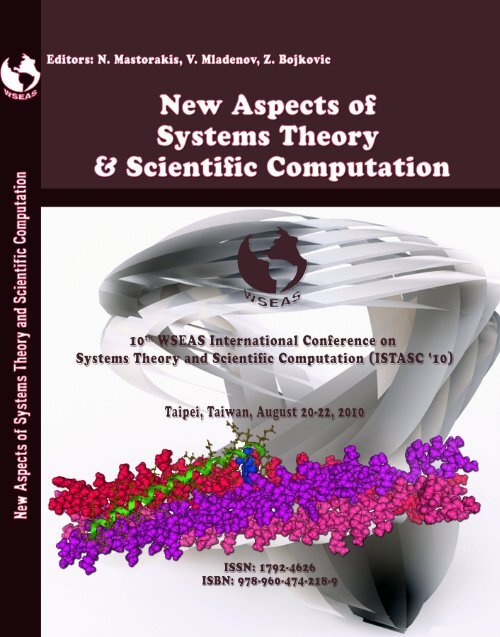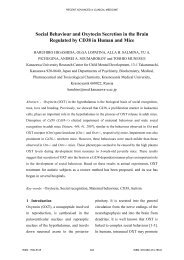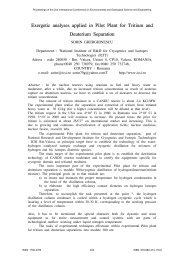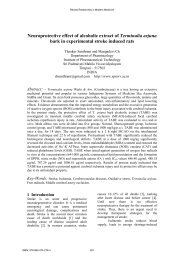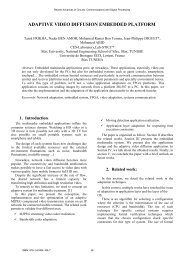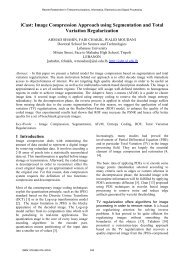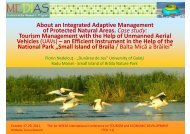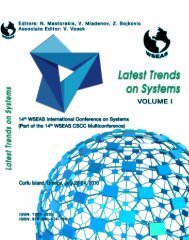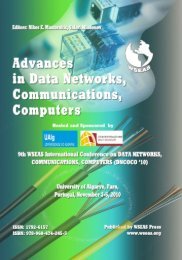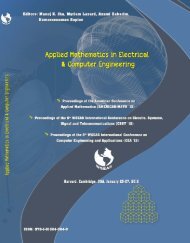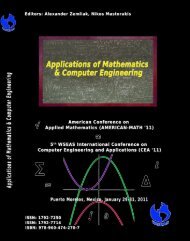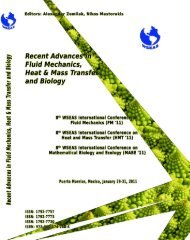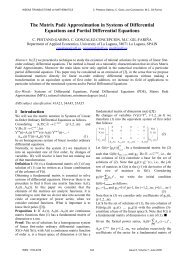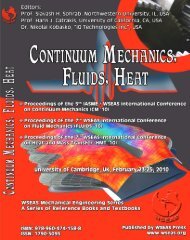NEW ASPECTS of SYSTEMS THEORY and SCIENTIFIC ... - WSEAS
NEW ASPECTS of SYSTEMS THEORY and SCIENTIFIC ... - WSEAS
NEW ASPECTS of SYSTEMS THEORY and SCIENTIFIC ... - WSEAS
You also want an ePaper? Increase the reach of your titles
YUMPU automatically turns print PDFs into web optimized ePapers that Google loves.
<strong>NEW</strong> <strong>ASPECTS</strong> <strong>of</strong> <strong>SYSTEMS</strong><br />
<strong>THEORY</strong> <strong>and</strong> <strong>SCIENTIFIC</strong><br />
COMPUTATION<br />
10th <strong>WSEAS</strong> International Conference on <strong>SYSTEMS</strong> <strong>THEORY</strong><br />
AND <strong>SCIENTIFIC</strong> COMPUTATION (ISTASC '10)<br />
Taipei, Taiwan<br />
August 20-22, 2010<br />
Mathematics <strong>and</strong> Computers in Science Engineering<br />
A Series <strong>of</strong> Reference Books <strong>and</strong> Textbooks<br />
Published by <strong>WSEAS</strong> Press ISSN: 1792-4626<br />
www.wseas.org ISBN: 978-960-474-218-9
<strong>NEW</strong> <strong>ASPECTS</strong> <strong>of</strong> <strong>SYSTEMS</strong><br />
<strong>THEORY</strong> <strong>and</strong> <strong>SCIENTIFIC</strong><br />
COMPUTATION<br />
10th <strong>WSEAS</strong> International Conference on <strong>SYSTEMS</strong> <strong>THEORY</strong><br />
AND <strong>SCIENTIFIC</strong> COMPUTATION (ISTASC '10)<br />
Taipei, Taiwan, August 20-22, 2010<br />
Mathematics <strong>and</strong> Computers in Science Engineering<br />
A Series <strong>of</strong> Reference Books <strong>and</strong> Textbooks<br />
Published by <strong>WSEAS</strong> Press<br />
www.wseas.org<br />
Copyright © 2010, by <strong>WSEAS</strong> Press<br />
All the copyright <strong>of</strong> the present book belongs to the World Scientific <strong>and</strong> Engineering Academy <strong>and</strong><br />
Society Press. All rights reserved. No part <strong>of</strong> this publication may be reproduced, stored in a retrieval<br />
system, or transmitted in any form or by any means, electronic, mechanical, photocopying, recording, or<br />
otherwise, without the prior written permission <strong>of</strong> the Editor <strong>of</strong> World Scientific <strong>and</strong> Engineering Academy<br />
<strong>and</strong> Society Press.<br />
All papers <strong>of</strong> the present volume were peer reviewed by two independent reviewers. Acceptance was<br />
granted when both reviewers' recommendations were positive.<br />
See also: http://www.worldses.org/review/index.html<br />
ISSN: 1792-4626<br />
ISBN: 978-960-474-218-9<br />
World Scientific <strong>and</strong> Engineering Academy <strong>and</strong> Society
<strong>NEW</strong> <strong>ASPECTS</strong> <strong>of</strong> <strong>SYSTEMS</strong><br />
<strong>THEORY</strong> <strong>and</strong> <strong>SCIENTIFIC</strong><br />
COMPUTATION<br />
10th <strong>WSEAS</strong> International Conference on <strong>SYSTEMS</strong> <strong>THEORY</strong><br />
AND <strong>SCIENTIFIC</strong> COMPUTATION (ISTASC '10)<br />
Taipei, Taiwan<br />
August 20-22, 2010
Editors:<br />
Pr<strong>of</strong>. Nikos E. Mastorakis, BULGARIA<br />
Pr<strong>of</strong>. Valeri Mladenov, BULGARIA<br />
Pr<strong>of</strong>. Zoran Bojkovic, SERBIA<br />
International Program Committee Members:<br />
Antonio Alves, BRAZIL<br />
Nowshad Amin, MALAYSIA<br />
Horia Andrei, ROMANIA<br />
A. Andreatos, GREECE<br />
E. Antonidakis, GREECE<br />
Rafic Bachnak, UNITED STATES<br />
Nikos Bardis, GREECE<br />
Dimitri Bertsekas, USA<br />
Luigino Benetazzo, ITALY<br />
Krishnamurthy Bhat, INDIA<br />
Yuval Bistritz, ISRAEL<br />
Razvan Bologa ROMANIA<br />
Taxiarchis Botsis, NORWAY<br />
El ouahidi Bouabid, MOROCCO<br />
Hamida Bougherira, ALGERIA<br />
Comes Calin-Adrian, ROMANIA<br />
Leon Chua, USA<br />
Massimiliano Caramia, ITALY<br />
George Carutasu,ROMANIA:<br />
Costin Cepisca, ROMANIA<br />
Shang-Kuan Chen, TAIWAN<br />
Cheng-chuan Chen, TAIWAN<br />
Chin-Tun Chuang, TAIWAN<br />
Daniel Cristian Cismaru, ROMANIA<br />
Spiros Courellis, UNITED STATES<br />
Krzyszt<strong>of</strong> Cyran, POLAND<br />
Masumeh Damrudi, IRAN<br />
Carlo Dell'Aquila ,ITALY<br />
Beixing Deng, CHINA<br />
Radu Dobrescu, ROMANIA<br />
Bojan Dolsa,k SLOVENIA<br />
Petr Ekel,BRAZIL<br />
Darie Eleonora, ROMANIA<br />
Abeer El-korany, EGYPT<br />
Monica Enache, ROMANIA<br />
Sorin Enache, ROMANIA<br />
Wen-Pinn Fang, TAIWAN<br />
Hassan Farsi, IRAN<br />
Adrian Filipescu, ROMANIA<br />
Maria I. Garcia Planas, SPAIN<br />
Ioannis Gonos, GREECE<br />
Eladio Gutierrez, SPAIN<br />
Daphne Halkias, GREECE<br />
Mohamed Hamada, JAPAN<br />
Florin Hartescu, ROMANIA<br />
Andrei Horvat-Marc, ROMANIA<br />
Chen-Chien Hsu, TAIWAN<br />
Ya-Hsin Hsueh, TAIWAN<br />
Tauqeer Hussain, PAKISTAN<br />
Fumiaki Imado, JAPAN<br />
Konstantinos Ioannou, GREECE<br />
Adrian Ionescu, UNITED STATES<br />
Shahram Javadi, IRAN<br />
Ming-Jer Jeng, TAIWAN<br />
Tadeusz Kaczorek, POLAND<br />
Devinder Kaur, UNITED STATES<br />
Stamatios Kartalopoulos, USA<br />
Mila Kazic, MONTENEGRO<br />
Nikos Koutsoupias, GREECE<br />
Deniss Kuml<strong>and</strong>er, ESTONIA<br />
Aouni A. Lakis, CANADA<br />
Athina Lazakidou, GREECE<br />
Keon Myung Lee, KOREA<br />
Stanca Liana-Maria, ROMANIA<br />
Seongan Lim, KOREA<br />
Jiann-Horng Lin, TAIWAN<br />
Fern<strong>and</strong>o Lorenzo-Garcia, SPAIN<br />
Ming-chih Lu, TAIWAN<br />
Xia Mao ,CHINA<br />
Castor Marino, SPAIN<br />
Zuzana Martinakova ,SLOVAKIA<br />
George Mavrommatis, GREECE<br />
Baritz Mihaela ,ROMANIA<br />
S<strong>and</strong>a Florentina Mihalache, ROMANIA<br />
Sallehuddin Mohamed Haris, MALAYSIA<br />
Maria Mor<strong>and</strong>i Cecchi, ITALY<br />
Abdelaziz Mourad ALGERIA<br />
Hossein, Shahram, IRAN<br />
Marina Novak, SLOVENIA<br />
Mirko Novak, CZECH REPUBLIC<br />
Vicenzo Niola, ITALY<br />
Manuela Panoiu, ROMANIA<br />
Kostas Passadis, GREECE<br />
Camelia M. Pintea ROMANIA<br />
Sebastiano Pizzutilo, ITALY<br />
Ioannis Pountourakis, GREECE<br />
Nicolae Pop, ROMANIA<br />
Dan Popescu, ROMANIA<br />
Dorin Popescu, ROMANIA<br />
Nicolae Popoviciu, ROMANIA<br />
Martin Poupa, CZECH REPUBLIC<br />
Ioannis Prousalidis, GREECE<br />
Mircea Preda, ROMANIA<br />
Valeriu Prepelictua, ROMANIA<br />
Ricardo Quiros, SPAIN<br />
Dobrescu Radu, ROMANIA<br />
Mohammadreza Rafiei, IRAN<br />
Victor Manuel Rivas Santos, SPAIN<br />
Buchmann Robert Andrei, ROMANIA<br />
Marcos Rodrigues, UNITED KINGDOM<br />
Leszek Rutkowski, POLAND<br />
Saeed-Reza Sabbagh-Yazdi, IRAN
Hiroshi Sakaki, JAPAN<br />
Abdel Sebak, CANADA<br />
Takao Shimomura ,JAPAN<br />
Vairis Shtrauss, LATVIA<br />
Vladislav Skorpil CZECH REPUBLIC<br />
Wanrudee Skulpakdee, THAILAND<br />
Gi<strong>and</strong>omenico Spezzano, ITALY<br />
Ioannis Stathopulos, GREECE<br />
George Stavrakakis, GREECE<br />
Milan Stork, CZECH REPUBLIC<br />
Yumi Takizawa, JAPAN<br />
Horatiu Teodorescu, ROMANIA<br />
Chen Tianzhou, CHINA<br />
Chen Tonglong, CHINA<br />
Fragkiskos Topalis, GREECE<br />
Carlos Torre-ferrero, SPAIN<br />
Maria Trenas, SPAIN<br />
Dimos Triantis, GREECE<br />
Constantin Udriste, ROMANIA<br />
Filippos Vallianatos, GREECE<br />
Ioannis Vardiambassis, GREECE<br />
Argyrios Varonides, USA<br />
Anastassios Venetsanopoulos, USA<br />
Vladimir Vasek CZECH REPUBLIC<br />
Ti-ho Wang, TAIWAN<br />
Ming-Shi Wang, TAIWAN<br />
Wei-yen Wang ,TAIWAN<br />
Fuli Wu, CHINA<br />
Chikatoshi Yamada, JAPAN<br />
Zheng Yan, FINLAND<br />
Byumi Youssef, EGYPT<br />
Lotfi A. Zadeh, USA<br />
Stelios Zimeras, GREECE
Preface<br />
This year the 10th <strong>WSEAS</strong> International Conference on <strong>SYSTEMS</strong> <strong>THEORY</strong> AND<br />
<strong>SCIENTIFIC</strong> COMPUTATION (ISTASC '10) was held in Taipei, Taiwan, August 20-22, 2010.<br />
The conference remains faithful to its original idea <strong>of</strong> providing a platform to discuss dynamical<br />
systems, control systems, control engineering, s<strong>of</strong>t computing, discrete event dynamic systems,<br />
manufacturing systems, decentralised systems, remote sensing, game theory, identification,<br />
number theory, error estimation in iterative methods, eigenvalue problems, numerical methods<br />
for singular equations, error analysis, stability problems, convergence problems, combinatorial<br />
programming, integer programming, convex, nonsmooth <strong>and</strong> variational analysis, multiobjective<br />
programming, r<strong>and</strong>omized algorithms, equational logic programming, network optimization,<br />
approximation algorithms, theoretical computer science, coding <strong>and</strong> information theory, errorcorrecting<br />
codes, data compression, switching networks, communication protocols etc. with<br />
participants from all over the world, both from academia <strong>and</strong> from industry.<br />
Its success is reflected in the papers received, with participants coming from several countries,<br />
allowing a real multinational multicultural exchange <strong>of</strong> experiences <strong>and</strong> ideas.<br />
The accepted papers <strong>of</strong> this conference are published in this Book that will be indexed by ISI.<br />
Please, check it: www.worldses.org/indexes as well as in the CD-ROM Proceedings. They will<br />
be also available in the E-Library <strong>of</strong> the <strong>WSEAS</strong>. The best papers will be also promoted in many<br />
Journals for further evaluation.<br />
A Conference such as this can only succeed as a team effort, so the Editors want to thank the<br />
International Scientific Committee <strong>and</strong> the Reviewers for their excellent work in reviewing the<br />
papers as well as their invaluable input <strong>and</strong> advice.<br />
The Editors
<strong>NEW</strong> <strong>ASPECTS</strong> <strong>of</strong> <strong>SYSTEMS</strong> <strong>THEORY</strong> <strong>and</strong> <strong>SCIENTIFIC</strong> COMPUTATION<br />
Table <strong>of</strong> Contents<br />
Plenary Lecture 1: A New Artificial Intelligence in Game Design - Introduction to<br />
Reinforcement Learning<br />
Shao-Shin Hung<br />
Plenary Lecture 2: Analytical Synthesis Method - A New Mathematical Design Method for the<br />
Analog Circuit Design<br />
Chun-Ming Chang<br />
12<br />
13<br />
Plenary Lecture 3: Multi-attribute Intelligent Grey Target Decision Model 15<br />
Sifeng Liu<br />
Plenary Lecture 4: Science for Life or Live for Science, Take the RFID System <strong>and</strong> e-Learning<br />
for Example<br />
Ming-Shen Jian<br />
Plenary Lecture 5: Analysis <strong>of</strong> Robust Stability <strong>of</strong> Variable Structure Control in Frequency<br />
Domain<br />
Chingyei Chung<br />
Plenary Lecture 6: Multimedia System Learning – D-Learning Way on Science <strong>and</strong><br />
Technological Course<br />
Tsai-Hua Lin<br />
17<br />
19<br />
20<br />
Plenary Lecture 7: Design <strong>and</strong> Application <strong>of</strong> Cerebellar Model Articulation Controllers 21<br />
Chih-Min Lin<br />
Adaptive-Fuzzy-Identification-Based Sliding-Mode Control for Linear Ultrasonic Motor 23<br />
Chih-Min Lin, Ang-Bung Ting, Ming-Chia Li<br />
Item Hierarchy for Statistical Concepts Analysis Based on Learning Style <strong>of</strong> University<br />
Students<br />
Jui-Yu Ko, Yuan-Horng Lin<br />
A Comparison Theorem for Stochastic Differential Equations <strong>and</strong> its Applications in<br />
Economics<br />
Li Xia Ma, Gen Qi Xu, Nikos E. Mastorakis<br />
29<br />
34<br />
Inverse Problem <strong>of</strong> Networks–Reconstruction <strong>of</strong> Graph 41<br />
Lei Wang, Gen Qi Xu, Nikos E. Mastorakis<br />
Integration <strong>of</strong> Polytomous IRS <strong>and</strong> S-P Chart in Concept Diagnosis <strong>of</strong> Fraction Addition Based<br />
on Learning Styles<br />
Yuan-Horng Lin, Ming-Hua Liu<br />
The Selection <strong>of</strong> Regional Key Technology Based on the Hybrid Model <strong>of</strong> Grey Fixed<br />
Clustering <strong>and</strong> Variable Precision Rough Set<br />
Jian Lirong, Liu Sifeng, Liu Yong<br />
48<br />
54<br />
ISSN: 1792-4626 9 ISBN: 978-960-474-218-9
<strong>NEW</strong> <strong>ASPECTS</strong> <strong>of</strong> <strong>SYSTEMS</strong> <strong>THEORY</strong> <strong>and</strong> <strong>SCIENTIFIC</strong> COMPUTATION<br />
On the Factors Influencing the Competitiveness <strong>of</strong> Chinese Service Trade after Entering WTO<br />
- An Analysis Based on Grey Incidence<br />
Ying Wang<br />
60<br />
Concurrent Implementation <strong>of</strong> Differential Evolution 65<br />
Kiyoharu Tagawa, Takashi Ishimizu<br />
Clustering <strong>of</strong> EEG Data Using Maximum Entropy Method <strong>and</strong> LVQ 71<br />
Yuji Mizuno, Hiroshi Mabuchi, Goutam Chakraborty, Masafumi Matsuhara<br />
Impact <strong>of</strong> Flights Delays on Productivity <strong>of</strong> Yangtze River Delta Airports 77<br />
Wei Wei, Xia Hongshan<br />
Apples <strong>and</strong> Oranges? Comparing Unconventional Computers 83<br />
Ed Blakey<br />
Optimization <strong>of</strong> Limit Characteristics in Opened Queueing Networks 89<br />
Gurami Tsitsiashvili<br />
An Intelligent Fuzzy/Cointegration Analysis for Systematic Risk 94<br />
Shun-Jyh Wu, Shu-Ling Lin<br />
Multiobjective Genetic Algorithm to Solve the Train Crew Scheduling Problem 100<br />
Ming-Shen Jian, Ta-Yuan Chou<br />
A Novel Fuzzy Measure <strong>and</strong> its Extensional Signed Fuzzy Measure 107<br />
Hsiang-Chuan Liu, Tung-Sheng Liu<br />
Design <strong>of</strong> Control Systems Based on Vector Error 112<br />
Oleg N. Agamalov<br />
Strategic Alliance <strong>and</strong> Competitiveness in Taiwan Speakers <strong>and</strong> Amplifiers Firms 121<br />
Rong-Jyue Fang, Chun-Wei Lu, Hua-Lin Tsai, Yung-Sheng Chang<br />
Domestic Management <strong>of</strong> Foreign Direct Investments by Japanese Manufacturers in Vietnam 128<br />
Rong-Jyue Fang, Chun-Wei Lu, Hua-Lin Tsai, Yung-Sheng Chang<br />
Petrochemical Employees’ Vocational Alienation - Kaohsiung County 135<br />
Chung-Shan Sun, Li-Hsing Chen, Hua-Lin Tsai<br />
A Study <strong>of</strong> Communication Technology Education - Take PHS Phones as Example in<br />
Elementary School<br />
Rong-Jyue Fang, Hua-Lin Tsai, Chun-Wei Lu, Chi-Jen Lee, Yung-Sheng Chang<br />
142<br />
Analysis <strong>of</strong> Robust Stability <strong>of</strong> Variable Structure Control in Frequency Domain 147<br />
Chingyei Chung, H. I. Chin, Shou-Yen Chao, M. F. Lu<br />
Stable in State Constrained Control <strong>of</strong> Discrete-Time Systems 153<br />
Anna Filasova, Dusan Krokavec<br />
Characterizing an Extended Fuzzy Logic System with Temporal Attributes for Real-Time<br />
Expert Systems<br />
Vasile Mazilescu<br />
159<br />
ISSN: 1792-4626 10 ISBN: 978-960-474-218-9
<strong>NEW</strong> <strong>ASPECTS</strong> <strong>of</strong> <strong>SYSTEMS</strong> <strong>THEORY</strong> <strong>and</strong> <strong>SCIENTIFIC</strong> COMPUTATION<br />
Stabilization <strong>of</strong> Abstract Delay Systems on Banach Lattices 166<br />
Tomoaki Hashimoto<br />
Investment Project Valuation Using a Fuzzy Real Options Approach 172<br />
Shu-Hsien Liao, Shiu-Hwei Ho<br />
hybridFS: Integrating NAND Flash-Based SSD <strong>and</strong> HDD for Hybrid File System 178<br />
Jinsun Suk, Jaechun No<br />
Bacterial Foraging Optimization <strong>and</strong> Tabu Search: Performance Issues <strong>and</strong> Cooperative<br />
Algorithms<br />
Nuapett Sarasiri, Sarawut Sujitjorn<br />
186<br />
GA-Based Optimal PIDA Controller Design 192<br />
Sunisa Sornmuang, Sarawut Sujitjorn<br />
Action Prediction <strong>of</strong> Opponents in MMORPG using Data Stream Mining Approach with<br />
Heuristic Motions<br />
Chih-Ming Chiu, Shao-Shin Hung<br />
198<br />
A Machinima-like 3D Animation Production System 208<br />
Ming-Yuhe Chang, Chih-Ming Chiu, Shao-Shin Hung<br />
Intelligent-Based Latency Reduction in 3D Walkthrough 218<br />
Tsou Tsun Fu, Shao-Shin Hung, Hui-Ling Lin, Derchian Tsaih, Jung Tzung Chen<br />
Computer-Aided Modeling <strong>of</strong> the Dynamic Behavior for Multi-Body Branched Systems 227<br />
Carmen E. Eisinger Borcia<br />
A Study on Ontology Structure Matching 234<br />
Li-Hua Li, Rong-Wang Hsu, Shao-Shin Hung, Yu-Chien Chou, Tsung-Jen Pu<br />
Price Bundling for Personalized Recommendation 243<br />
Li-Hua Li, Rong-Wang Hsu, Shao-Shin Hung, Pei-Jung Tsai<br />
Performance Analysis <strong>of</strong> 65 nm nMOS Using CoSi2 <strong>and</strong> TiSi2 252<br />
Megat Mohd Izhar Sapeli, Taib Ziad Mohamad, Badariah Bais, M. Najib Harif<br />
PID Controller Based Intelligent Fuzzy Control <strong>of</strong> a SPM System Design 258<br />
Jium-Ming Lin, Po-Kuang Chang<br />
Beverage Stores – Headquarters Performance Assessment in Taiwan 264<br />
An-Yuan Chang, Chih-Hung Hsu, Cong-Wei Lee<br />
Authors Index 269<br />
ISSN: 1792-4626 11 ISBN: 978-960-474-218-9
<strong>NEW</strong> <strong>ASPECTS</strong> <strong>of</strong> <strong>SYSTEMS</strong> <strong>THEORY</strong> <strong>and</strong> <strong>SCIENTIFIC</strong> COMPUTATION<br />
Plenary Lecture 1<br />
A New Artificial Intelligence in Game Design - Introduction to Reinforcement Learning<br />
Assistant Pr<strong>of</strong>essor Shao-Shin Hung<br />
Department <strong>of</strong> Computer Science <strong>and</strong> Information Engineering<br />
WuFu Institute <strong>of</strong> Technology<br />
Taiwan<br />
E-mail: hss@cs.ccu.edu.tw<br />
Abstract: The past few years have seen steady improvements in computer technology for graphics, sound,<br />
networking <strong>and</strong> processing power. Computer-controlled, non-player characters facilitate games <strong>and</strong> activities in these<br />
worlds <strong>and</strong> may interact with hundreds <strong>of</strong> thous<strong>and</strong>s <strong>of</strong> human-controlled characters. The game theory domain is<br />
been widely regarded as appropriate for underst<strong>and</strong>ing the concepts <strong>of</strong> machine learning. Scientists usually focus on<br />
strategic games <strong>and</strong> make efforts to create “intelligent” programs that efficiently compete with human players. Such<br />
games are suitable for further studying because <strong>of</strong> their complexity <strong>and</strong> the opportunities they <strong>of</strong>fer to explore winning<br />
strategies However, artificial intelligence technology to control non-player characters has, so far, lagged behind<br />
advances in other virtual world technologies. There is now a need for more believable <strong>and</strong> intelligent non-player<br />
characters to support <strong>and</strong> enhance virtual world applications.<br />
This speech presents a new artificial intelligence technique – motivated reinforcement learning – for the development<br />
<strong>of</strong> non-player characters in multiuser games. On the other side, reinforcement learning is considered as one <strong>of</strong> the<br />
most suitable <strong>and</strong> prominent methods for solving game problems due to its capability to discover good strategies by<br />
extended self-training <strong>and</strong> limited initial knowledge. For example, humans <strong>and</strong> animals have the ability to focus <strong>and</strong><br />
adapt their behavior. These behavioral traits are also an advantage for artificial agents in complex or dynamic<br />
environments, where only a small amount <strong>of</strong> available information may be relevant at a particular time, <strong>and</strong> relevant<br />
information changes over time. Motivated reinforcement learning combines computational models <strong>of</strong> motivation with<br />
advanced machine learning algorithms – to empower non-player characters to self identify new tasks on which to<br />
focus their attention <strong>and</strong> learn about.<br />
Finally, both theoretical <strong>and</strong> practical issues are addressed for developing adaptive, dynamic non-player characters.<br />
Focus applications include multiuser, role-playing <strong>and</strong> simulation games.<br />
Brief Biography <strong>of</strong> the Speaker:<br />
Shao-Shin Hung received the MS. <strong>and</strong> Ph.D. degrees Computer Science <strong>and</strong> Information Engineering from National<br />
Cheng Chung University Taiwan, in 1992 <strong>and</strong> 2007, respectively.<br />
Currently, he is an Assistant Pr<strong>of</strong>essor at the Department <strong>of</strong> Computer Science <strong>and</strong> Information Engineering, WuFu<br />
Institute <strong>of</strong> Technology. He serves as a program committee <strong>of</strong> the 2nd Int. Multi-Conference on Engineering <strong>and</strong><br />
Technological Innovation (IMETI09), the 4th International Conference on Ubiquitous Information Technologies &<br />
Applications (ICUT 2009). He also serves as an Associate Editor/Editorial Board member <strong>of</strong> the following<br />
international journals, such as the Open S<strong>of</strong>tware Engineering Journal, the Open Industrial <strong>and</strong> Manufacturing<br />
Engineering Journal, <strong>and</strong> the Open Artificial Intelligence Journal. He is a paper reviewer <strong>of</strong> Vis'07, Vis'08, VAST'08,<br />
Vis'09 <strong>and</strong> Journal <strong>of</strong> Information Science.<br />
His research interests include computational intelligence, data mining, intrusion detection <strong>and</strong> applications <strong>of</strong> 3D<br />
game system tools. He is a member <strong>of</strong> the ACM <strong>and</strong> the IEEE Computer Society.<br />
ISSN: 1792-4626 12 ISBN: 978-960-474-218-9
<strong>NEW</strong> <strong>ASPECTS</strong> <strong>of</strong> <strong>SYSTEMS</strong> <strong>THEORY</strong> <strong>and</strong> <strong>SCIENTIFIC</strong> COMPUTATION<br />
Plenary Lecture 2<br />
Analytical Synthesis Method - A New Mathematical Design Method for the Analog Circuit<br />
Design<br />
Pr<strong>of</strong>essor Chun-Ming Chang<br />
Dept. <strong>of</strong> Electrical Engineering<br />
Chung Yuan Christian University<br />
Chung-Li, Taiwan 32023<br />
R. O. China<br />
E-mail: chunming@dec.ee.cycu.edu.tw<br />
Abstract: Analytical Synthesis Method (ASM) has been presented in several papers published in the IEEE<br />
Transactions on Circuits <strong>and</strong> Systems since 2003. It is one <strong>of</strong> the powerful design methods in the field <strong>of</strong> analog<br />
circuit design. It is the method using a succession <strong>of</strong> innovative algebra manipulation operations to decompose a<br />
complicated transfer function representing the relationship between the output <strong>and</strong> the input signals <strong>of</strong> a design<br />
project into many simple equations feasible by using the corresponding simple sub-circuitries. The simple subcircuitries<br />
can be constructed by the desired configuration <strong>of</strong> the element such as the single-ended-input operational<br />
transconductance amplifiers (OTAs) <strong>and</strong> the grounded capacitors, both <strong>of</strong> which are used for absorbing <strong>and</strong> reducing<br />
the shunt parasitic capacitance <strong>and</strong> lead to have more precise output responses. In addition to this, the ASM can<br />
control the number <strong>of</strong> the terms in the complicated decomposition process such that the number <strong>of</strong> both active <strong>and</strong><br />
passive components used in the circuit is the least compared to the previously reported ones. Then, the ASM is the<br />
only one method which can simultaneously achieve the three important criteria for the design <strong>of</strong> OTA-C circuits<br />
without trade-<strong>of</strong>f.<br />
Due to the flexibility <strong>of</strong> the ASM, the simple sub-circuitries used in the circuit design can be changed <strong>and</strong> chosen<br />
according to different necessities for the target <strong>of</strong> the circuit design. For example, if the reduction <strong>of</strong> the number <strong>of</strong> the<br />
active <strong>and</strong> passive components used in the circuit is more important than the type <strong>of</strong> the element configurations like<br />
single-ended-input/differential-input OTAs <strong>and</strong> grounded/floating capacitors due to the consideration about power<br />
consumption, chip area, noise, <strong>and</strong> total parasitics……, etc., the minimum component OTA-C circuit can also be<br />
investigated <strong>and</strong> developed successfully using the ASMs. The fully flexible characteristic <strong>and</strong> the real demonstration<br />
in the literature <strong>of</strong> the ASM may make it be one <strong>of</strong> the most prospective methods in the field <strong>of</strong> analog circuit design in<br />
the near future.<br />
Brief Biography <strong>of</strong> the Speaker:<br />
Chun-Ming Chang received the B.S.E.E. <strong>and</strong> M.S.E.E. degrees from National Cheng Kung University, Tainan,<br />
Taiwan, R. O. C. in 1975 <strong>and</strong> 1977, respectively, <strong>and</strong> the Ph.D. degree from the University <strong>of</strong> Southampton,<br />
Southampton, U.K., in 2004.<br />
In 1979, he joined the Department <strong>of</strong> Electrical Engineering, Taipei Institute <strong>of</strong> Technology, Taipei, Taiwan, R. O. C.,<br />
as a Lecturer. After one year, he transferred to the Department <strong>of</strong> Electronic Engineering, Fu Jen Catholic University,<br />
Taipei Hsien, Taiwan, R.O.C. In 1982, he joined the Department <strong>of</strong> Electrical Engineering, Chung Yuan Christian<br />
University, Chung-Li, Taiwan, R.O.C., where he became an Associate Pr<strong>of</strong>essor <strong>and</strong> a Full Pr<strong>of</strong>essor in 1985 <strong>and</strong><br />
1991, respectively. He is currently a Pr<strong>of</strong>essor <strong>of</strong> Electrical Engineering <strong>and</strong> leader <strong>of</strong> the Electronic Circuits Group in<br />
the Department <strong>of</strong> Electrical Engineering, Chung Yuan Christian University. He is also a departmental teacher<br />
promotion committee member <strong>and</strong> a college teacher promotion committee member. He was the chairman <strong>of</strong> the<br />
Department <strong>of</strong> Electrical Engineering <strong>of</strong> Chung Yuan Christian University from 1995 to 1999. His research interests<br />
are divided into two parts: network synthesis <strong>and</strong> analog circuit design before <strong>and</strong> after 1991, respectively. The<br />
improvement for the approach technique to factorize a paramount matrix used in network synthesis <strong>and</strong> proposed by<br />
Pr<strong>of</strong>essor I. Cederbaum let him be promoted to a Full Pr<strong>of</strong>essor in 1991. He has published over 70 SCI papers, in<br />
which the most famous is the invention <strong>of</strong> a new analytical synthesis method for the design <strong>of</strong> analog circuits which<br />
can, for the first time, simultaneously achieve three important criteria for the design <strong>of</strong> OTA-C filters without trade-<strong>of</strong>fs.<br />
Using a succession <strong>of</strong> innovative algebra manipulation operations, a complicated nth-order transfer function can be<br />
decomposed into a set <strong>of</strong> simple equations feasible using the single-ended-input OTAs <strong>and</strong> grounded capacitors.<br />
Several IEEE Transaction papers on Circuits <strong>and</strong> Systems with analytical synthesis method have been published in<br />
ISSN: 1792-4626 13 ISBN: 978-960-474-218-9
<strong>NEW</strong> <strong>ASPECTS</strong> <strong>of</strong> <strong>SYSTEMS</strong> <strong>THEORY</strong> <strong>and</strong> <strong>SCIENTIFIC</strong> COMPUTATION<br />
the literature since 2003. Recently, he was invited as the Plenary Speaker <strong>of</strong> the (i) 7th <strong>WSEAS</strong> International<br />
Conference on Instrumentation, Measurement, Circuits <strong>and</strong> Systems (IMCAS ’08), Hangzhou China, April 6-8, 2008;<br />
(ii) 8th <strong>WSEAS</strong> International Conference on Electronics, Hardware, Wireless <strong>and</strong> Optical Communications<br />
(EHAC’09), University <strong>of</strong> Cambridge, UK, February 21-23, 2009; <strong>and</strong> (iii) 11th <strong>WSEAS</strong> International Conference on<br />
Mathematical <strong>and</strong> Computational Methods in Science <strong>and</strong> Engineering (MACMESE’09), Baltimore USA, November 7-<br />
9, 2009. He is in the process <strong>of</strong> writing his pr<strong>of</strong>essional textbook: “Analog Circuit Design---Analytical Synthesis<br />
Method”.<br />
Pr<strong>of</strong>. Chang is a senior member <strong>of</strong> the IEEE Circuits <strong>and</strong> Systems Society.<br />
ISSN: 1792-4626 14 ISBN: 978-960-474-218-9
<strong>NEW</strong> <strong>ASPECTS</strong> <strong>of</strong> <strong>SYSTEMS</strong> <strong>THEORY</strong> <strong>and</strong> <strong>SCIENTIFIC</strong> COMPUTATION<br />
Plenary Lecture 3<br />
Multi-attribute Intelligent Grey Target Decision Model<br />
Pr<strong>of</strong>essor Sifeng Liu<br />
Director <strong>of</strong> Institute for Grey Systems Studies<br />
President <strong>of</strong> Grey Systems Society <strong>of</strong> China<br />
Vice-president <strong>of</strong> Chinese Society for Optimization, Overall Planning <strong>and</strong> Economic<br />
Mathematics<br />
Dean <strong>of</strong> College <strong>of</strong> Economics <strong>and</strong> Management, Nanjing University <strong>of</strong> Aeronautics <strong>and</strong><br />
Astronautics<br />
29 Imperial Street, Nanjing 210016, PR China<br />
E-mail: sfliu@nuaa.edu.cn<br />
Abstract: A new multi-attribute intelligent grey target decision model is put forward in this paper. Four kind uniform<br />
effect measures <strong>of</strong> the effect measure for benefit type objective, the effect measure for cost type objective, the lower<br />
effect measure for moderate type, <strong>and</strong> the upper effect measure for moderate type have been formed in view <strong>of</strong><br />
different decision objective <strong>of</strong> benefit type, cost type, <strong>and</strong> moderate type which with a pleased field. Accordingly, the<br />
decision objectives which with different meaning, different dimension, <strong>and</strong>/or different nature can be transferred to<br />
uniform effect measure. So, the matrix <strong>of</strong> synthetic effect measures can be obtained easily. The critical value <strong>of</strong> grey<br />
target is designed as the dividing point <strong>of</strong> positive <strong>and</strong> negative, that is the zero point. It with very clear physical<br />
meaning. And the two cases <strong>of</strong> hit the bull’s eye or not <strong>of</strong> the objective effect value are fully considered. The<br />
distinguishing rate between synthetic effect measures are improved greatly.<br />
Brief Biography <strong>of</strong> the Speaker:<br />
Pr<strong>of</strong>essor Sifeng Liu received his bachelor’s degree in mathematics from Henan University, China, in 1981, his MS in<br />
economics <strong>and</strong> his PhD in systems engineering from Huazhong University <strong>of</strong> Science <strong>and</strong> Technology, China, in<br />
1986 <strong>and</strong> 1998, respectively. He has been to Slippery Rock University in Slippery Rock, Pennsylvania <strong>and</strong> Sydney<br />
University in Sydney, Australia as a visiting pr<strong>of</strong>essor. At present, Pr<strong>of</strong>essor Liu is the Director <strong>of</strong> the Institute for Grey<br />
Systems Studies <strong>and</strong> the dean <strong>of</strong> the College <strong>of</strong> Economics <strong>and</strong> Management <strong>of</strong> Nanjing University <strong>of</strong> Aeronautics<br />
<strong>and</strong> Astronautics(NUAA); he is also a distinguished pr<strong>of</strong>essor <strong>and</strong> guide for doctoral students in management science<br />
<strong>and</strong> systems engineering disciplines.<br />
Dr. Liu’s main research activities are in grey systems theory <strong>and</strong> regional technical innovation management. He has<br />
directed more than 50 projects at national, provincial or ministerial levels, has participated in international cooperation<br />
projects, <strong>and</strong> has published over 200 research papers <strong>and</strong> 18 monographs <strong>and</strong> edited volumes published by famous<br />
publishers, such as Springer, Taylor <strong>and</strong> Francis, <strong>and</strong> Science Press. He is currently a co- editor <strong>of</strong> the book series<br />
"Systems Evaluation, Prediction <strong>and</strong> Decision-Making," published by CRC Press, an imprint <strong>of</strong> Taylor <strong>and</strong> Francis.<br />
Dr. Liu is a member <strong>of</strong> the evaluation committee <strong>of</strong> Natural Science Foundation <strong>of</strong> China(NSFC), a member <strong>of</strong> the<br />
st<strong>and</strong>ing committee for teaching guide in management science <strong>and</strong> engineering <strong>of</strong> the Ministry <strong>of</strong> Education, China.<br />
He also serves as an expert on s<strong>of</strong>t science at the Ministry <strong>of</strong> Science <strong>and</strong> Technology, China. Pr<strong>of</strong>essor Liu currently<br />
serves as the chair <strong>of</strong> the Technical Committee <strong>of</strong> the IEEE SMC on Grey Systems, the president <strong>of</strong> Grey Systems<br />
Society <strong>of</strong> China(GSSC), a vice president <strong>of</strong> Chinese Society for Optimization, Overall Planning <strong>and</strong> Economic<br />
Mathematics(CSOOPEM), a vice chair <strong>of</strong> Beijing Chapter Of IEEE SMC, a vice chair <strong>of</strong> Nanjing Chapter Of IEEE<br />
SMC, a vice president <strong>of</strong> Econometrics <strong>and</strong> Management Science Society <strong>of</strong> Jiangsu Province(EMSSJS) <strong>and</strong> a vice<br />
president <strong>of</strong> Systems Engineering Society <strong>of</strong> Jiangsu Province(SESJS), a member <strong>of</strong> the Nanjing Decision<br />
Consultancy Committee. He serves as a member <strong>of</strong> the editorial board <strong>of</strong> over 10 pr<strong>of</strong>essional journals, including<br />
"The Journal <strong>of</strong> Grey System (UK)," "Scientific Inquiry (USA)", "Journal <strong>of</strong> Grey System (Taiwan)", "Chinese Journal<br />
<strong>of</strong> Management Science", "Systems Theory <strong>and</strong> Applications", "Science & Technology Progress <strong>and</strong><br />
Policy","Systems Science <strong>and</strong> Comprehensive Studies in Agriculture", <strong>and</strong> "the Journal <strong>of</strong> Nanjing University <strong>of</strong><br />
Aeronautics <strong>and</strong> Astronautics".<br />
Dr. Liu has won several accolades such as the "National Excellent Teacher" in 1995, "Excellent Expert <strong>of</strong> Henan<br />
Province" in 1998, "Excellent Science <strong>and</strong> Technology Staff in Jiangsu Province" in 2002 ,"Expert Enjoying<br />
ISSN: 1792-4626 15 ISBN: 978-960-474-218-9
<strong>NEW</strong> <strong>ASPECTS</strong> <strong>of</strong> <strong>SYSTEMS</strong> <strong>THEORY</strong> <strong>and</strong> <strong>SCIENTIFIC</strong> COMPUTATION<br />
Government’s Special Allowance" in 2000, "National Expert with Prominent Contribution" in 1998, <strong>and</strong> "Outst<strong>and</strong>ing<br />
Managerial Personnel <strong>of</strong> China " in 2005.<br />
ISSN: 1792-4626 16 ISBN: 978-960-474-218-9
<strong>NEW</strong> <strong>ASPECTS</strong> <strong>of</strong> <strong>SYSTEMS</strong> <strong>THEORY</strong> <strong>and</strong> <strong>SCIENTIFIC</strong> COMPUTATION<br />
Plenary Lecture 4<br />
Science for Life or Live for Science, Take the RFID System <strong>and</strong> e-Learning for Example<br />
Assistant Pr<strong>of</strong>essor Ming-Shen Jian<br />
Dept. <strong>of</strong> Computer Science <strong>and</strong> Information Engineering<br />
National Formosa University<br />
Yunlin County, Taiwan<br />
E-mail: mingshen@edith.cse.nsysu.edu.tw<br />
Abstract: Today, many researcher <strong>and</strong> scholars propose various algorithms, theories, <strong>and</strong> systems via proposals,<br />
papers, <strong>and</strong> presentations. Every year, there are more than thous<strong>and</strong>s papers proposed in different conferences or<br />
journals. In addition, there are many graduates from universities <strong>and</strong> research institute. However, how many<br />
algorithms or systems are realistic or realized is an interesting question. In the world, many companies claim that<br />
their products or technologies come from human nature. In fact, there are huge differences between the technologies<br />
proposed <strong>and</strong> implemented. It also makes the graduates work on the job with less relation to the researches they did.<br />
Due to the location, culture, <strong>and</strong> behavior habits, the researches implemented in the laboratory may not be suitable<br />
for people or satisfy the requirements at the specific location. To enhance the feasibility <strong>of</strong> the research or algorithms,<br />
considering the distance between laboratory <strong>and</strong> reality is important. Sometimes, researchers or students implement<br />
the technologies just because that they suppose to. In fact, the end users or general users <strong>of</strong> the technologies<br />
services should be the most important targets that the researchers have to take into account. In other words, how to<br />
encourage people to adopt the technologies or make people interest in these technologies is important. An<br />
acceptable or interesting technology may have the chance to be realizable or implemented by business model.<br />
The RFID system today is general. However, even there are many researchers who proposed their ideas or papers,<br />
the technologies implemented around us are only a few. Some researches present that the RFID system can achieve<br />
some functions <strong>and</strong> capabilities. Most RFID systems until now still work as the identification key <strong>of</strong> the guard systems<br />
or monitoring applications. Some new RFID applications work as one method or type <strong>of</strong> payment such as<br />
metropolitan rapid transportation card. The ideas in the laboratory may be good <strong>and</strong> efficient but are not realized or<br />
accepted in the life. In other words, some or more conditions <strong>and</strong> limitations such as the cost, the behavior, the<br />
procedure, even the dem<strong>and</strong> <strong>of</strong> these ideas should be carefully considered.<br />
Another famous application: e-learning has been considered <strong>and</strong> implemented for a long time. Most researchers in<br />
this area know or completely underst<strong>and</strong> one <strong>of</strong> the st<strong>and</strong>ards: SCORM. It is a procedure or st<strong>and</strong>ard process for an<br />
engineer to implement a e-learning material or system. Many papers, applications, or systems are proposed <strong>and</strong><br />
realized. However, the e-learning system which is really interesting for students or is are based on the content, even<br />
there are many researchers who propose the possible <strong>and</strong> new structure or applications year by year. Researchers<br />
<strong>and</strong> engineers pay too much attention to the technologies themselves than to take the users or students into account.<br />
In other words, the proposed systems or applications may force the people to conform to the systems. It means that<br />
the users just can follow the technical procedure made by the engineer even they are not technical staffs.<br />
Engineers or researchers provide the new <strong>and</strong> better technologies or systems to general users. The more important<br />
issue is: "Are these technologies, algorithms, <strong>and</strong> applications needed by users?" In addition, some questions about<br />
science should be also considered: 1) Is it provided to improve the life <strong>and</strong> to be completely better than the original<br />
function or application, sometimes even can instead <strong>of</strong> the original one, 2) Does it provide another choice or function<br />
for users dealing with the original application, or 3) Does it encourage users changing their original habits or suiting<br />
the new technology? To make the science or technology useful <strong>and</strong> beneficial for users, "User" should be the most<br />
important factor.<br />
Brief Biography <strong>of</strong> the Speaker:<br />
Ming-Shen Jian is an assistant pr<strong>of</strong>essor at the Dept. <strong>of</strong> Computer Science <strong>and</strong> Information Engineering <strong>of</strong> the<br />
National Formosa University in Yunlin County, Taiwan from 2009. He received the Ph.D. degree in Computer Science<br />
<strong>and</strong> Engineering <strong>of</strong> the National Sun Yet-Sen University in Kaohsiung City, Taiwan, in 2007. He got his B.S. degree in<br />
Electronic <strong>and</strong> Control Engineering <strong>of</strong> the National Chiao Tung University in Hsinchu City, Taiwan, in 2000.<br />
He was the consultant <strong>of</strong> the International Semiconductor Technology Ltd. <strong>and</strong> International Megatrend Smart<br />
Technology Ltd. (2007~2008) <strong>and</strong> an assistant pr<strong>of</strong>essor at the Dept. <strong>of</strong> Computer Science <strong>and</strong> Communication<br />
ISSN: 1792-4626 17 ISBN: 978-960-474-218-9
<strong>NEW</strong> <strong>ASPECTS</strong> <strong>of</strong> <strong>SYSTEMS</strong> <strong>THEORY</strong> <strong>and</strong> <strong>SCIENTIFIC</strong> COMPUTATION<br />
Engineering in Shu Te University in Kaohsiung County, Taiwan (2008). His current research interests are in the area<br />
related to Integration <strong>of</strong> RFID system, e-learning <strong>and</strong> game for learning, <strong>and</strong> cloud computing.<br />
ISSN: 1792-4626 18 ISBN: 978-960-474-218-9
<strong>NEW</strong> <strong>ASPECTS</strong> <strong>of</strong> <strong>SYSTEMS</strong> <strong>THEORY</strong> <strong>and</strong> <strong>SCIENTIFIC</strong> COMPUTATION<br />
Plenary Lecture 5<br />
Analysis <strong>of</strong> Robust Stability <strong>of</strong> Variable Structure Control in Frequency Domain<br />
Pr<strong>of</strong>essor Chingyei Chung<br />
Department <strong>of</strong> Electronic Engineering<br />
Ming Shin University <strong>of</strong> Science <strong>and</strong> Technology<br />
Taiwan R.O.C.<br />
E-mail: plu_chung@yahoo.com.tw<br />
Abstract: Conventionally, the variable structure control is investigated in the time domain. However, this paper xplore<br />
the properties <strong>of</strong> robust stability for variable structure control in frequency domain. Here, it can be shown that the<br />
variable structure control can be transformed into a Lur’e problem. If the uncertainties <strong>of</strong> system <strong>and</strong> input matrices<br />
satisfy the “matching conditions”, then the zero dynamics <strong>of</strong> sliding surface will not changed; For robust stability, it<br />
can be shown that from frequency domain point <strong>of</strong> view, the variable structure control possesses phase margin <strong>and</strong><br />
infinity gain margin. With this point <strong>of</strong> view, the sliding mode control reveals superior robust properties. Finally,<br />
according to circle criterion, a formula is presented that with suitable boundary layer, the sliding mode control can<br />
achieve absolute stability <strong>of</strong> overall system.<br />
Brief Biography <strong>of</strong> the Speaker:<br />
Chingyei Chung is a pr<strong>of</strong>essor in the Department <strong>of</strong> Electronic Engineering, Ming Shin University <strong>of</strong> Science <strong>and</strong><br />
Technology, Taiwan Prior to this position, he held various academic positions at Feng Chia University Taiwan <strong>and</strong><br />
San Francisco State University, USA respectively. He received B.S. from Natl. Chiao Tung University, Taiwan ROC<br />
<strong>and</strong> M.S. degree in electrical engineering from San Jose State University, U.S.A. Also He finished his Ph.D degree in<br />
Mechanical Engineering from University <strong>of</strong> California, Berkeley, USA.<br />
He has four Patents granted by the United State Patent <strong>and</strong> Trademark Office. In 2003, he is an Distinguished<br />
Research Advisor in ABI (American Biographic Institute). His research interests include nonlinear control, nonlinear<br />
circuit theory <strong>and</strong> etc.<br />
ISSN: 1792-4626 19 ISBN: 978-960-474-218-9
<strong>NEW</strong> <strong>ASPECTS</strong> <strong>of</strong> <strong>SYSTEMS</strong> <strong>THEORY</strong> <strong>and</strong> <strong>SCIENTIFIC</strong> COMPUTATION<br />
Plenary Lecture 6<br />
Multimedia System Learning – D-Learning Way on Science <strong>and</strong> Technological Course<br />
Pr<strong>of</strong>essor Tsai-Hua Lin<br />
Department <strong>of</strong> Information Management<br />
College <strong>of</strong> Management, STUT<br />
Taiwan<br />
E-mail: kittyhl@gmail.com<br />
Abstract: Based on the functions <strong>of</strong> theoretical foundations <strong>and</strong> related literature analysis, study group develop a<br />
multimedia system named: D-Learning way on science <strong>and</strong> technological course. The original purpose <strong>of</strong> research<br />
work targeting on constructing a learning platform for three-dimensional computer animation. The feasibility was<br />
based on the evaluated functions <strong>of</strong> D-Learning animation techniques <strong>and</strong> the prototype constructed. Platform<br />
derived from three-dimensional computer animation technique associated with ASP.NET <strong>and</strong> SQL Database.<br />
This Model aims at probing into meaning <strong>and</strong> purpose <strong>of</strong> the Nature <strong>and</strong> Science Technology course, studying the<br />
way, <strong>and</strong> implementing the tactics concretely, combining information science <strong>and</strong> technology <strong>and</strong> applying every<br />
discipline teaching actually.<br />
Brief Biography <strong>of</strong> the Speaker:<br />
Dr. Tsai-Hua Lin – 2009 graduated from The Department <strong>of</strong> Industrial Technology Education, National Kaohsiung<br />
Normal University PhD program. She had been Director <strong>of</strong> Computation Center, later, been a President <strong>of</strong> National<br />
Taitung (East Taiwan) University. In 2010, she concentrates her research on multimedia hardware, learnung, <strong>and</strong><br />
system development for more than twenty years <strong>and</strong> gain more than twenty years financial support from Taiwan’s<br />
National Science Council. In recent years, she works mostly on 3D Interactive Model Web learning.<br />
ISSN: 1792-4626 20 ISBN: 978-960-474-218-9
<strong>NEW</strong> <strong>ASPECTS</strong> <strong>of</strong> <strong>SYSTEMS</strong> <strong>THEORY</strong> <strong>and</strong> <strong>SCIENTIFIC</strong> COMPUTATION<br />
Plenary Lecture 7<br />
Design <strong>and</strong> Application <strong>of</strong> Cerebellar Model Articulation Controllers<br />
Pr<strong>of</strong>essor Chih-Min Lin<br />
Electrical Engineering Deptartment<br />
Yuan Ze University, Taiwan<br />
E-mail: cml@saturn.yzu.edu.tw<br />
Abstract: Based on biological prototype <strong>of</strong> human brain <strong>and</strong> improved underst<strong>and</strong>ing <strong>of</strong> the functionality <strong>of</strong> the<br />
neurons <strong>and</strong> the pattern <strong>of</strong> their interconnections in the brain, a theoretical model used to explain the informationprocessing<br />
characteristics <strong>of</strong> the cerebellum was developed independently by Marr (1969) <strong>and</strong> Albus (1971). The<br />
cerebellar model articulation controller (CMAC) was first proposed by Albus in 1974. The CMAC is a learning<br />
structure that imitates the organization <strong>and</strong> functionality <strong>of</strong> the cerebellum <strong>of</strong> the human brain. That model revealed<br />
the structure <strong>and</strong> functionality <strong>of</strong> the various cells <strong>and</strong> fibers in the cerebellum. The core <strong>of</strong> CMAC is an associative<br />
memory which has the ability to approach complex nonlinear functions. The CMAC takes advantage <strong>of</strong> the inputredundancy<br />
by using distributed storage <strong>and</strong> can learn nonlinear functions extremely quickly due to the on-line<br />
adjustment <strong>of</strong> its system parameters. The CMAC is classified as a non-fully connected perceptron-like associative<br />
memory network with overlapping receptive-fields. It has good generalization capability <strong>and</strong> fast learning property <strong>and</strong><br />
is suitable for a lot <strong>of</strong> applications. This speech introduces several CMAC-based adaptive learning systems; these<br />
systems combine the advantages <strong>of</strong> CMAC identification, adaptive learning <strong>and</strong> control techniques. In these systems,<br />
the on-line parameter training methodologies, using the Lyapunov stability theorem, are proposed to increase the<br />
learning capability. Moreover, the applications <strong>of</strong> these systems in servomotor control, missile guidance systems,<br />
biped robot <strong>and</strong> computer-aided diagnostic <strong>of</strong> breast nodules are demonstrated.<br />
Brief Biography <strong>of</strong> the Speaker:<br />
Pr<strong>of</strong>. Chih-Min Lin is currently a Chair Pr<strong>of</strong>essor <strong>of</strong> Electrical Engineering, Yuan Ze University, Taiwan. He also<br />
serves as the Editor-in-Chief <strong>of</strong> <strong>WSEAS</strong> Trans. Systems <strong>and</strong> Control <strong>and</strong> Associate Editor <strong>of</strong> IEEE Trans. Systems,<br />
Man, <strong>and</strong> Cybernetics, Part B; Asian Journal <strong>of</strong> Control; <strong>and</strong> International Journal <strong>of</strong> Fuzzy Systems. He is now the<br />
Chair <strong>of</strong> IEEE Systems, Man, <strong>and</strong> Cybernetics Society, Taipei Chapter, <strong>and</strong> Board <strong>of</strong> Government <strong>of</strong> IEEE Taipei<br />
Section. His research interests include fuzzy systems, neural network, cerebellar model articulation controller, <strong>and</strong><br />
intelligent control systems. He is an IEEE Fellow <strong>and</strong> IET Fellow. He has published 96 journal papers <strong>and</strong> 134<br />
conference papers.<br />
ISSN: 1792-4626 21 ISBN: 978-960-474-218-9
<strong>NEW</strong> <strong>ASPECTS</strong> <strong>of</strong> <strong>SYSTEMS</strong> <strong>THEORY</strong> <strong>and</strong> <strong>SCIENTIFIC</strong> COMPUTATION<br />
Authors Index<br />
Agamalov, O. N. 112 Hung, S.-S. 198, 208, 218 Mazilescu, V. 159<br />
Bais, B. 252 Hung, S.-S. 234, 243 Mizuno, Y. 71<br />
Blakey, E. 83 Ishimizu, T. 65 Mohamad, T. Z. 252<br />
Borcia, C. E. E. 227 Jian. M.-S. 100 No, J. 178<br />
Chakraborty, G. 71 Ko, J.-Y. 29 Pu, T.-J. 234<br />
Chang, A.-Y. 264 Krokavec, D. 153 Sapeli, M. M. I. 252<br />
Chang, M.-Y. 208 Lee, C.-J. 142 Sarasiri, N. 186<br />
Chang, P.-K. 258 Lee, C.-W. 264 Sifeng, L. 54<br />
Chang, Y.-S. 121, 128, 142 Li, L.-H. 234, 243 Sornmuang, S. 192<br />
Chao, S.-Y. 147 Li, M.-C. 23 Sujitjorn, S. 186, 192<br />
Chen, J. T. 218 Liao, S.-H. 172 Suk, J. 178<br />
Chen, L.-H. 135 Lin, C.-M. 23 Sun, C.-S. 135<br />
Chin, H. I. 147 Lin, H.-L. 218 Tagawa, K. 65<br />
Chiu, C.-M. 198, 208 Lin, J.-M. 258 Ting, A.-B. 23<br />
Chou, T.-Y. 100 Lin, S.-L. 94 Tsai, H.-L. 121, 128, 135<br />
Chou, Y.-C. 234 Lin, Y.-H. 29, 48 Tsai, H.-L. 142<br />
Chung, C. 147 Lirong, J. 54 Tsai, P.-J. 243<br />
Fang, R.-J. 121, 128, 142 Liu, H.-C. 107 Tsaih, D. 218<br />
Filasova, A. 153 Liu, M.-H. 48 Tsitsiashvili, G. 89<br />
Fu, T. T. 218 Liu, T.-S. 107 Wang, L. 41<br />
Harif, M. N. 252 Lu, C.-W. 121, 128, 142 Wang, Y. 60<br />
Hashimoto, T. 166 Lu, M. F. 147 Wei, W. 77<br />
Ho, S.-H. 172 Ma, L. X. 34 Wu, S.-J. 94<br />
Hongshan, X. 77 Mabuchi, H. 71 Xu, G. Q. 34, 41<br />
Hsu, C.-H. 264 Mastorakis, N. E. 34, 41 Yong, L. 54<br />
Hsu, R.-W. 234, 243 Matsuhara, M. 71<br />
ISSN: 1792-4626 269 ISBN: 978-960-474-218-9


